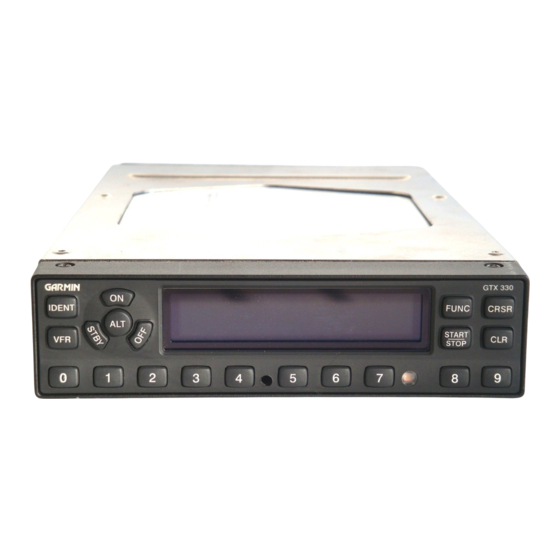Garmin GTX 330 파일럿 매뉴얼 부록 - 페이지 31
{카테고리_이름} Garmin GTX 330에 대한 파일럿 매뉴얼 부록을 온라인으로 검색하거나 PDF를 다운로드하세요. Garmin GTX 330 50 페이지. Equipment supplement
Garmin GTX 330에 대해서도 마찬가지입니다: 파일럿 매뉴얼 부록 (50 페이지), 파일럿 매뉴얼 (12 페이지), 파일럿 매뉴얼 (13 페이지), 파일럿 매뉴얼 (8 페이지), 파일럿 매뉴얼 (6 페이지), 파일럿 매뉴얼 (13 페이지), 매뉴얼 (8 페이지), 설치 매뉴얼 (49 페이지)

Part Three:
TAWS Interface
Section 1: Introduction
Overview
Garmin' s Terrain Awareness Warning System
(TAWS) is an optional feature (500W-series only) to
increase situational awareness and aid in reducing
controlled flight into terrain (CFIT). Garmin TAWS
satisfies TSO-C151b Class B requirements for
certification. Class B TAWS is required for all Part 91
turbine aircraft operations with six or more passenger
seats and for Part 135 turbine aircraft operations
with six to nine passenger seats (FAR Parts 91.223,
135.154).
Garmin TAWS satisfies TSO-C151b Class B
requirements for certification
Operating Criteria
Garmin TAWS requires the following to operate
properly:
• The system must have a valid 3D GPS position
solution
• The system must have a valid terrain/obstacle
database
GPS Position and GPS-MSL Altitude
Garmin TAWS uses information provided from
the 500W Series GPS receiver to provide a horizontal
position and altitude. GPS altitude is derived from
satellite measurements. GPS altitude is converted to
a Mean Sea Level (MSL)-based altitude (GPS-MSL
Altitude) and is used to determine TAWS alerts. GPS-
MSL Altitude accuracy is affected by factors such as
satellite geometry, but is not subject to variations in
pressure and temperature that normally affect pressure
altitude devices. GPS-MSL Altitude does not require
local altimeter settings to determine MSL Altitude.
Therefore, GPS altitude provides a highly accurate and
reliable MSL altitude source to calculate terrain and
obstacle alerts.
TAWS Alerting using the GPS Position/GPS-MSL
Altitude
Garmin TAWS utilizes terrain and obstacle
databases that are referenced to Mean Sea Level
(MSL). Using the GPS Position and GPS-MSL
Altitude, Garmin TAWS portrays a 2D picture of
the surrounding terrain and obstacles relative to the
position and altitude of the aircraft. Furthermore,
the GPS Position and GPS-MSL Altitude are used
to calculate and "predict" the aircraft' s flight path in
relation to the surrounding terrain and obstacles. In
this manner, the Garmin TAWS system can provide
advanced alerts of predicted dangerous terrain
conditions. Detailed alert modes are described further
in Part Three, Section 3.
Baro-Corrected Altitude verses GPS-MSL Altitude
Baro-Corrected Altitude (or Indicated Altitude)
is derived by adjusting the altimeter setting for the
local atmospheric conditions. The most accurate
Baro-Corrected Altitude can be achieved by frequently
updating the altimeter setting to the nearest reporting
station along the flight path. However, because actual
Part Three: Section 1
TAWS Introduction
27
